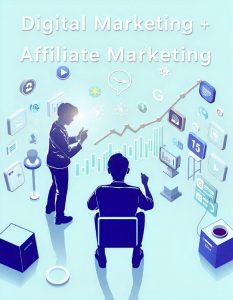Pay-per-click (PPC) advertising has become one of the most effective ways to drive traffic, generate leads, and increase conversions. PPC allows businesses to reach their target audience at the exact moment they are searching for specific products, services, or information online. Whether you’re new to digital advertising or looking to improve your strategy, this comprehensive guide will explain the ins and outs of PPC, how it works, its benefits, and best practices for running successful campaigns.
Affiliate Marketing with Us – Sell our Digital Products as an affiliate marketer
What is Pay-Per-Click (PPC) Advertising?
Pay-per-click (PPC) advertising is a digital advertising model in which advertisers pay a fee each time someone clicks on their ad. Essentially, it’s a way of buying visits to your website rather than earning them organically. PPC ads can appear on search engines, social media platforms, or other websites, depending on the ad network used.
The most popular form of PPC advertising is through search engines like Google Ads or Bing Ads, where ads are displayed at the top or bottom of search results pages. Advertisers bid on specific keywords related to their products or services, and when users search for those terms, the ads are shown.
How Does PPC Advertising Work?
Here’s a simplified breakdown of how PPC advertising works:
1. Ad Auction
PPC operates on an auction system. When you create a PPC ad, you bid on specific keywords that you want your ad to show up for. The amount you are willing to pay for each click on your ad is known as your bid.
2. Keyword Targeting
Keywords are the words or phrases users type into search engines. To run a PPC campaign, advertisers choose relevant keywords for their target audience. For example, if you own a shoe store, you might bid on keywords like “buy running shoes” or “best shoes for running.”
3. Ad Placement
When users search for the keywords you’ve bid on, an auction occurs behind the scenes. Search engines like Google take into account several factors to decide which ads will appear at the top of the search results. These factors include:
- Bid amount (how much you’re willing to pay per click)
- Quality Score (how relevant and well-optimized your ad is)
- Ad Rank (a combination of your bid and Quality Score)
4. Payment
You only pay when someone clicks on your ad. This is what makes PPC unique. Unlike traditional advertising, where you pay for ad space regardless of how many people engage with it, PPC allows you to only pay when users take action.
How To Make Money With The Moniepoint Bank App
Types of PPC Ads
PPC ads can take different forms, depending on where they are displayed and the campaign goals. The most common types include:
1. Search Ads
These are text-based ads that appear on search engine results pages (SERPs) when someone searches for specific keywords. Search ads are highly targeted and appear at the top or bottom of the SERP.
2. Display Ads
Display ads are typically image-based ads that appear on websites within Google’s Display Network. They are often used for brand awareness and retargeting, allowing you to show ads to users who have already visited your website.
3. Shopping Ads
For e-commerce businesses, shopping ads (also known as product listing ads) show product images, prices, and descriptions on search engine results pages. These ads are perfect for showcasing specific products and driving online sales.
4. Social Media Ads
PPC ads can also be run on social media platforms like Facebook, Instagram, LinkedIn, and Twitter. These ads can include images, videos, or carousel formats and target users based on demographics, interests, and behaviors.
5. Video Ads
Video ads can be displayed on platforms like YouTube or within social media feeds. These ads engage users through video content and are ideal for promoting products or increasing brand awareness.
How to Earn Money Online – The Ultimate Guide to Financial Freedom
Benefits of PPC Advertising
PPC advertising offers several key advantages for businesses of all sizes:
1. Instant Traffic
Unlike organic SEO strategies, which can take time to yield results, PPC ads drive instant traffic to your website. As soon as your campaign is live, your ads can appear at the top of search results or on relevant websites, providing immediate visibility.
2. Highly Targeted
PPC allows you to reach your ideal audience with precision. You can target users based on location, language, device, search intent, and even specific demographics or interests. This level of targeting ensures your ads are shown to the right people at the right time.
With PPC, you only pay when someone clicks on your ad. This pay-as-you-go model means you’re not wasting money on ads that don’t generate engagement. Additionally, you can set a daily or monthly budget, giving you full control over your advertising spend.
4. Measurable Results
PPC provides detailed analytics, allowing you to track the performance of your campaigns in real time. You can see how many people clicked on your ad, how much each click cost, and how well your ads are converting. This data helps you refine your strategy and optimize your ads for better results.
5. Flexible and Scalable
Whether you’re a small business with a modest budget or a large company with a bigger advertising spend, PPC is scalable. You can start small and gradually increase your budget as you see positive results.
Best Practices for Running Successful PPC Campaigns
To get the most out of your PPC efforts, it’s essential to follow best practices that maximize your ad’s effectiveness and ensure a high return on investment (ROI).
1. Choose the Right Keywords
Keyword research is crucial for PPC success. Use tools like Google Keyword Planner to find relevant keywords with high search volume and moderate competition. Focus on long-tail keywords (e.g., “best running shoes for men”) that are more specific and often have a lower cost per click (CPC).
2. Create Compelling Ad Copy
Your ad copy needs to be clear, concise, and persuasive. Highlight the benefits of your product or service and include a strong call-to-action (CTA) to encourage clicks. Also, ensure that your ad copy matches the intent of the user’s search query.
3. Optimize Landing Pages
A well-optimized landing page is essential for converting clicks into leads or sales. Make sure your landing page is relevant to the ad and provides a seamless user experience. It should load quickly, be mobile-friendly, and have a clear CTA that encourages visitors to take action.
4. Monitor and Adjust Your Bids
Managing your bid strategy is key to getting the best results from your PPC campaigns. You can choose between manual bidding (setting your bid amounts yourself) or automated bidding (letting the platform adjust bids for you). Continuously monitor your campaigns to ensure your bids are competitive without overspending.
5. Use Negative Keywords
Negative keywords prevent your ads from showing up for irrelevant searches. For example, if you’re selling premium shoes, you may want to add “cheap” as a negative keyword to avoid attracting users looking for low-cost options.
6. Run A/B Testing
A/B testing involves creating different versions of your ads (or landing pages) and testing which performs better. By running A/B tests, you can identify what resonates best with your audience and optimize your campaigns for higher performance.
7. Leverage Ad Extensions
Ad extensions allow you to add extra information to your PPC ads, such as phone numbers, links to specific pages, or customer reviews. These extensions make your ads more informative and increase the likelihood of getting clicks.
Affiliate Marketing for Remote Workers: How to Start Earning Commissions from Your Digital Presence
Common PPC Advertising Platforms
Here are some of the most popular platforms for running PPC ads:
1. Google Ads
Google Ads is the most widely used PPC platform, allowing businesses to display search ads, display ads, shopping ads, and video ads across Google’s vast network. It offers robust targeting options and advanced tools for optimizing campaigns.
2. Bing Ads
Although not as popular as Google, Bing Ads is an effective platform for reaching users who use Microsoft’s Bing search engine. The bidding process is similar to Google Ads, and it’s often less competitive, making it a cost-effective option for businesses.
3. Facebook Ads
Facebook Ads allows you to target users based on demographics, interests, and behaviors. You can create highly visual ads that appear in users’ newsfeeds, on Instagram, or Facebook Stories.
4. LinkedIn Ads
LinkedIn Ads is ideal for B2B businesses looking to reach professionals. You can target users based on their job title, company, industry, and more.
Pay-per-click (PPC) advertising is a powerful digital marketing tool that enables businesses to reach their audience instantly and drive targeted traffic to their websites. With its flexibility, scalability, and measurable results, PPC provides an excellent way to generate leads, increase conversions, and grow your brand.
By carefully selecting the right keywords, creating compelling ad copy, and continuously optimizing your campaigns, you can maximize your PPC results and achieve a high return on investment. Whether you’re a small business or a large enterprise, PPC advertising offers valuable opportunities to boost your online visibility and meet your marketing goals.
Top Free Digital Marketing Online Courses to Boost Your Skills (Get List And Websites)
Subscribe to Safegate World for daily updates.
Check Out Our Premium Services
To Advertise, Advertise Your Affiliate Links on Safegateworld.com
Become a Digital Marketer – Your Complete Guide with 500 Digital Marketing Sites To Start Your Career Immediately!
Related Articles
What Is Digital Marketing
Can Digital Marketing Make You Rich?
Digital Marketing and Affiliate Marketing
What Is Search Engine Optimization (SEO)?
Content Marketing
What is Email Marketing?















